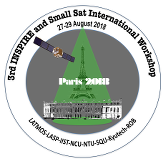Speaker
Dr
Luc Damé
(LATMOS/IPSL/CNRS/UVSQ)
Description
SoSWEET-SOUP is an innovative small satellites constellation which aims to measure on complementary platforms the solar influence on climate, namely on one part solar activity and spectral variability and, on the other, the different components of the Earth radiation budget, energy input and energy re-emitted at the top of the Earth atmosphere, with a particular focus on the UV part of the spectrum and on the ozone layer, which are most sensitive to solar variability. The far UV (FUV) is the only wavelength band with energy absorbed in the high atmosphere (stratosphere), in the ozone (Herzberg continuum, 200–220 nm) and oxygen bands, and its high variability is most probably at the origin of a climate influence. A simultaneous observation of the incoming FUV and of the ozone (O3) production, would bring an invaluable information on this process of solar-climate forcing. Space instruments have already measured the different components of the Earth radiative budget but this is, to our knowledge, the first time that all instruments will be operated simultaneously on coordinated platforms. This characteristic guarantees by itself obtaining new significant original scientific results.
SoSWEET-SOUP is an evolution of the SUITS/SWUSV and SUMO proposed missions, acknowledging the scientific advantages of associating a constellation of 10 to 12 small satellites of some 20 to 30 kg (12 "U" or so nanosatellites) on equatorial orbits (+/- 20° in latitude) to a small polar satellite of 100 to 120 kg on a OneWeb like platform for an almost continuous solar following (a polar orbit is also essential to the understanding of the relation between solar UV variability and stratospheric ozone on arctic and antarctic regions).
SoSWEET-SOUP definition's options are still under assessment but will include, on the polar satellite, SUAVE (Solar Ultraviolet Advanced Variability Experiment), an optimized heavy-duty thermally stable SiC telescope for FUV (Lyman-Alpha) and MUV (200–220 nm Herzberg continuum) imaging (sources of variability, extreme events detection), and SOLSIM (SOLar Spectral Irradiance Monitor), a newly designed double-monochromator instrument covering the 170-340 nm ultraviolet spectral range and in within a limited mass-power budget. Other instruments include a small coronagraph, UV and ozone radiometers, Earth radiative budget assembly, Electron-Proton detectors and a vector magnetometer. The constellation of small satellites includes, on its side, precise ozone profiles measurements (miniGOMOS experiment with dual Sun and stars occultations) and detailed energy radiative budget monitors. Science objectives, mission profiles and model payloads will be presented and opportunities of missions and potential collaborations discussed.
Primary author
Dr
Luc Damé
(LATMOS/IPSL/CNRS/UVSQ)
Co-authors
Dr
Abdanour Irbah
(LATMOS / CNRS)
Dr
Alain SARKISSIAN
(LATMOS / UVSQ / UPMC / CNRS)
Mr
David Bolsée
(BIRA-IASB)
Dr
Dominique Sluse
(IASB)
Dr
Gaël Cessateur
(BIRA-IASB)
Dr
Jean-Philippe Duvel
(Laboratoire Météorologie Dynamique)
Dr
Marion Marchand
(LATMOS/IPSL/CNRS, U. Sorbonne)
Dr
Mustapha Meftah
(LATMOS / CNRS / Paris-Saclay University)
Mr
Nuno José Pereira
(BIRA-IASB)
Dr
Philippe Keckhut
(LATMOS/IPSL/CNRS, U. Paris-Saclay, U. Sorbonne)
Dr
Rémi Thieblemont
(CNRS)
Dr
slimane bekki
(cnrs)

